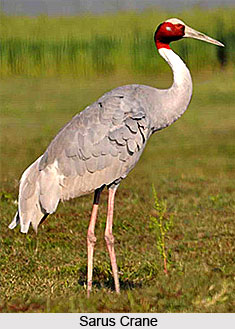 The Sarus Crane, Grus antigone is a resident breeding bird of India especially Central India and the Gangetic Plains. It is a large crane measuring five feet in length and is found in freshwater marshes and plains.
The Sarus Crane, Grus antigone is a resident breeding bird of India especially Central India and the Gangetic Plains. It is a large crane measuring five feet in length and is found in freshwater marshes and plains.
The adult Sarus crane is grey in colour with a bare red head and white crown with a long dark pointed bill. When the bird is flying, the long neck is straight unlike herons. The black wing tips can be seen when the bird is flying and the long red or pink legs behind them. The males and the females do not differ in colour but the younger birds are duller and browner in colour. Usually, the male is larger than the female. The average weight of the crane is 7.3 kilograms and therefore they are lighter in weight than Red crowned Cranes.
The Sarus crane birds are omnivorous and survive on insects, aquatic plants and animals, crustaceans, seeds and berries, small vertebrates and invertebrates. It builds its nest on the ground and lays two to three eggs in a normal clutch. The male and the female take care of the nest and the male is the main protector.



















